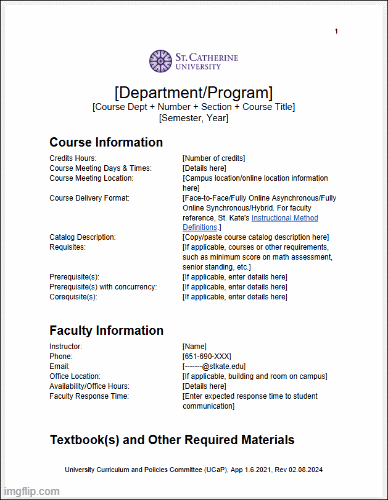
University Syllabus Information

Developing Your Syllabus
The content of your syllabus should be developed in accordance with your students' needs, teaching approach, and other external requirements, such as accreditation. However, the University Syllabus Guidelines outline the institutional requirements and recommended elements of a syllabus that meet the expectations of our accreditors.
Instructors are strongly encouraged to use the St. Kate's University Syllabus Template and the University Syllabus Guidelines when developing syllabi. This ensures that students receive a syllabus that meets university requirements as well as accessibility standards, particularly in terms of screen reader compatibility. The guidelines also ensure a consistent experience for students and demonstrate alignment between the course's student learning outcomes and methods of instruction and assessment.
Creating an Anti-Racist Syllabus
Inspired by our founders, the Sisters of St. Joseph of Carondelet, St. Catherine University is committed to academic excellence and educating women to lead and influence in a community characterized by respect for human dignity, equity, and solidarity. The mission of the Sisters of St. Joseph of Carondelet, "love of God and the dear neighbor without distinction," impels us to respond to the most urgent needs of society. We achieve this through intellectual inquiry, which leads to transformative leadership that drives action.
Below is a curated set of resources specifically geared toward Inclusive Excellence pedagogy. Additional information can be found on the Office of Equity and Belonging website.
Understanding Anti-Racist Pedagogy
- St. Kate's Anti-Racist Pedagogy Guide
- Practicing Anti-Racist Pedagogy
- The Anti-Racist Discussion Pedagogy
CUE Online Syllabus Review Guide
CUE’s tools are designed to help instructors explore and expand their agency for supporting racial equity in classroom experiences and outcomes.
Engaging Your Students with Your Syllabus
Because they tend to be long, dense, and full of academic-speak that can alienate students, consider incorporating one or more of the following strategies to help demystify your syllabus.
Go through the syllabus as a class.
This may be especially important for first-semester students.
This could be done as a large group.
- The teacher could read the syllabus aloud (or have students take turns reading it aloud), pausing after each section to allow students to ask questions and pose their own questions to check student understanding.

- During this activity, teachers could explain what elements of the syllabus are common across all of St. Kate’s and which are specific to their course.
- The teacher could turn the syllabus review into a social annotation exercise.
- Using a tool like Perusall or the Google Docs comment feature, the teacher could create a discussion in the text. Instructions might be for students to comment on 3 items they think are most important and explain why, and to pose 2 questions and respond to 1 peer’s question.
This also could be done in small groups.
- Each group could be given a section of the syllabus to cover. Their task would be to summarize/explain it to the class and come up with 1–2 questions they want to ask the teacher about it.
- The instructor could create a scavenger hunt activity, where students need to answer certain questions by finding different elements in the syllabus.
Have students read the syllabus independently.
- Take this “normal” activity one step further by creating a low-stakes quiz that accompanies a syllabus reading assignment. This quiz can be short, assessing their understanding of just the elements you deem most important.
Collaboratively build the syllabus as a class.
- University policies cannot be altered, but consider what elements of your syllabus your students might be able to have a say in and decide on those elements together. For example, can the students add a learning outcome to the class? Suggest types of major projects they’d like to complete (perhaps in lieu of a paper) or select topics for papers? Help decide the percent breakdown for elements that constitute their grade? Agree on a late assignment policy?
- Some classes will have more flexibility than others. In some disciplines, incorporating this type of collaboration may not be appropriate at all. In these classes, the teacher might still be able to incorporate the student voice by having the class work collaboratively on rules of engagement (for class discussions, for example).
The desire for agency is human nature, and including students in these decisions helps them feel more in control of their learning experience. This in turn can bolster their engagement and investment in your class.
We hope these resources will help you develop syllabi that are creative, compelling, and student-friendly while also meeting standards for accessibility and the requirements of accrediting bodies (Higher Learning Commission and your professional accrediting bodies).
If you have questions about these resources, please submit an Academic Tech Request.